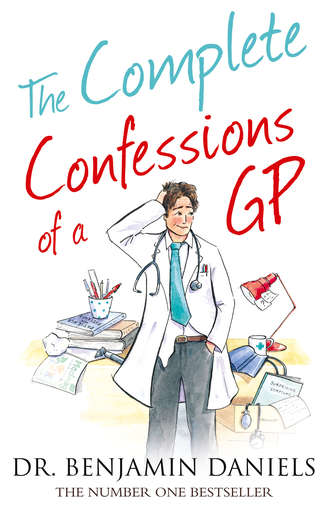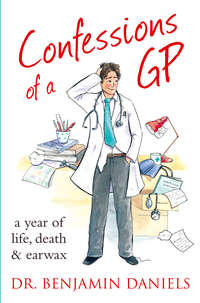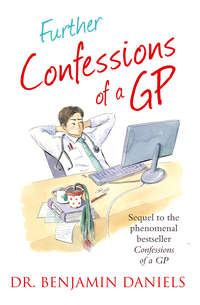
Полная версия
The Complete Confessions of a GP
Mrs Briggs
It is 3 a.m. on a Sunday night and I’m working on call for the ‘out-of-hours’ doctors. I get a call through to do an emergency visit. Before I arrive, I have only minimal information about what to expect. All I know is that I’m visiting Mrs Briggs who is in her seventies and has breast cancer.
When I arrive, five or six family members greet me at the door. I’m ushered upstairs in hushed silence and shown into a dimly lit bedroom. In front of me lies a skeleton of a woman. Pale and semi-conscious, she is quite clearly dying. In my years as a doctor I’ve seen many people die. In hospital it is all quite clinical. It is easier to think of them as the ‘stroke’ in bed 3 or the ‘lung cancer’ in cubicle 2, rather than as a real person. In the patient’s own home it is less easy to protect yourself from the enormity of somebody’s death. Surrounded by belongings and pictures of them looking healthy and contented during happier times, the dying person feels overwhelmingly real.
The daughter explains to me that her mum’s wish is to die at home and the family is determined to keep her out of hospital or hospice. Up until now she had been managing fairly well, drinking small amounts and her pain was well controlled with tablets. Unfortunately, over the course of the evening she had deteriorated quite rapidly and she was now agitated and seemed to be in pain. She was writhing around the bed and crying out. With end stage cancer, it is very unpredictable as to how and when someone will actually die. With heart attacks, it is easy to understand. The heart ceases being supplied with blood and oxygen so it stops and that’s it. A slow-growing tumour that spreads and eats you away from the inside makes you weak and frail but it is difficult to know exactly how and when it will finally kill you. I couldn’t be sure exactly what it was that was going to end Mrs Briggs’s life, but there was no doubt in my mind that she was going to die tonight.
One of the principal aims of palliative care is to keep the patient pain free until the end. Mrs Briggs was only semi-conscious and couldn’t answer my questions. I couldn’t be sure of exactly how aware she herself was of the pain, but she was certainly agitated and appeared distressed and I couldn’t leave her like this. It was also very upsetting for her family and they were desperate for me to do something. Mrs Briggs couldn’t take anything orally so I was going to need to give her an injection of something and that something was morphine. Since Harold Shipman, GPs have been extremely nervous about using morphine in this way. Dr Shipman used injections of morphine to kill his patients and so, understandably, my decision to inject a syringe of the stuff into Mrs Briggs wasn’t one to be taken lightly, especially as I knew that she could potentially die quite quickly as a result.
In an ideal world I would set up a syringe driver, which is a pump that slowly injects morphine automatically into the patient until the pain is controlled. But it was 3 a.m. and Mrs Briggs needed pain relief now. There was no way that I was going to be able to organise a syringe driver tonight. I took the family aside and explained that I wanted to give her an injection of morphine. I explained that it might decrease her level of consciousness but would ease the pain and agitation. The family was well aware that she only had a few hours left and they wanted them to be peaceful and pain free. They were happy for me to give the injection. I drew up the morphine into my syringe and slowly injected the clear fluid under her skin. In front of my eyes, her tense agitated body relaxed. I only gave her a few mils, but she had so little flesh on her that she didn’t need much for it to take effect. As Mrs Briggs’s writhing body calmed, so did the torment on the faces of her family. Her breathing became shallow and she slipped into a deep coma and died a few hours later.
Her family was immensely grateful. It wasn’t euthanasia, but perhaps my injection of morphine sped up her death by a few hours. Many of my day-to-day actions as a GP lead me to question the ethics of the choices I make. However, I never doubted that my decision to give Mrs Briggs morphine that night was the right thing to do. My fears about giving morphine are more about the family and how they might react. If I had thought that the family wasn’t on my side, I wouldn’t have given the morphine. Not because the wishes of the family are more important than the wellbeing of the patient, but because I wouldn’t want to have to defend my actions in court. Mrs Briggs would have suffered but I’m not prepared to be labelled as the ‘next Shipman’. People accuse doctors of playing God by choosing when patients live or die and sometimes we do, but as long as our decisions are made with compassion and not arrogance, I’ll make no apologies.
Betty Bale’s cat
Betty Bale is the only patient that I can remember from my first six-month stint as a doctor. She was admitted to my ward on my first day and was still in that same bed when I finished six months later. She was only in her late sixties but had suffered a severe stroke, which meant that she was pretty much completely paralysed. She could speak but it was slurred and she dribbled. It was always an effort to make out her words and even more of an effort for her to say them. She couldn’t swallow so had to be fed through a tube running straight into her stomach. All in all, it was a fairly miserable existence.
Strokes are unpredictable and some people recover all of their function, others none and most something in between. For the first few weeks, Betty had intensive specialist physio and speech therapist input, but it soon became clear that she wasn’t going to recover much of her movement. Previously independent, this was very difficult for Betty to accept. It was sensitively suggested by the consultant that she would need to go to a nursing home to be looked after. Betty’s speech was poor but she made it crystal clear where he could stick his nursing home idea. ‘I’m going home!’ she would shout as best she could. ‘I want to see my cat.’ Betty’s mind was as sharp as ever. She wasn’t confused about her diagnosis, she just hadn’t accepted it. If her disabilities had been more manageable, she could have gone home with carers visiting regularly. Unfortunately, Betty needed 24-hour nursing care because of her swallowing problems and severe paralysis.
Betty was taking up a hospital bed on an acute medical ward. It was a complete waste of resources as we were doing nothing for her, but she refused point blank to go to a nursing home and so what could we do? With intact marbles, we couldn’t ship her out against her will so we were stuck. Each morning we would do our ward round leaving Betty to last. Doctors hate feeling helpless so none of us really wanted to go in to see her. As the most junior member of the team, I was usually thrown in to say hello. My attempt at a friendly ‘good morning’ was always greeted with a stoical ‘I want to go home’ and invariably an ‘I want to see my cat.’ Betty had never married and had no children. She had painfully few visitors and we often heard her crying to herself as we hurried past her room. It was a miserable situation but one that seemed impossible to solve.
It was decided between the junior doctors and nurses that we were going to bring in her cat for a visit. We knew that if the consultant or, worse still, the infection control nurse found out, we would all be for the high jump, but after so many months of feeling so incapable of helping Betty, we decided we were finally going to do something for her. It was agreed we would sneak the cat in on her birthday. Like a military operation, the cat was picked up from Betty’s neighbour and smuggled on to the ward. The cat was a miserable old moggy with clumps of missing fur and she hissed at anyone who came close. We couldn’t believe that this was the precious creature that had been so desperately missed. Betty was, however, over the moon. ‘My cat, my cat!’ she cried. The cat herself seemed less than overwhelmed by the reunion but did at least allow Betty to hold her for a few minutes and even seemed to let out the odd token purr.
It would be nice to finish the story with Betty making a miracle recovery because of the amazing healing power of feline friendship, but that didn’t happen. Betty was still paralysed and eventually, after many reluctant months, did have to go to a nursing home. Betty’s case sticks in my mind because it shows how despite all the wonderful facilities that modern hospitals contain, it was a mangy cat that made one woman’s suffering lessen for a short period at least.
Конец ознакомительного фрагмента.
Текст предоставлен ООО «ЛитРес».
Прочитайте эту книгу целиком, купив полную легальную версию на ЛитРес.
Безопасно оплатить книгу можно банковской картой Visa, MasterCard, Maestro, со счета мобильного телефона, с платежного терминала, в салоне МТС или Связной, через PayPal, WebMoney, Яндекс.Деньги, QIWI Кошелек, бонусными картами или другим удобным Вам способом.







